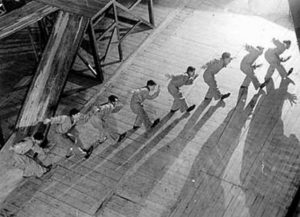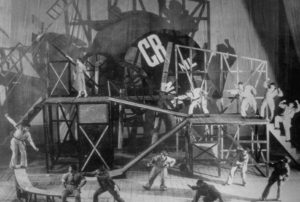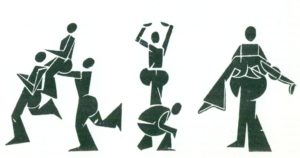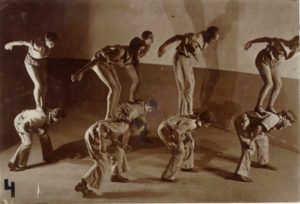Biomechanics was an acting technique developed by Vsevolod Meyerhold in answer to the problems of a changing theatre in the early 20th century. It coincided with a search for a more authentic acting experience. Russian theatre between the 1870s and early 1900s consisted of a series of classic plays which relied heavily, one could say exclusively, on the text and literature for their content. Productions were staged in the form a strictly realistic and naturalistic character. Meyerhold and others began to understand that theatre was an independent art form in itself with its own aesthetic and quality and should not be a slave to the written word and subjected to the tyranny of the text and the author of that text. Theatre for Meyerhold was a unique art form which should be “theatrical” and used all the possibilities of theatre, such as gesture and movement, as legitimate means of expression equal to that of the text. In other words, Meyerhold wanted to breakdown the usual hierarchies of theatre with the text, and the actors’ declamation of the text at its apex. Meyerhold’s contention was that the audience always understood that what they were seeing on stage was an illusion and not real life. He wanted to develop a new kind of theatre which would reflect the conditions of life which were literally appearing on the streets of Russia’s cities at the beginning of the twentieth century; speed, movement and mass culture.

Related to this was the problem of theatrical space itself. Meyerhold became interested in how the three-dimensional character of the actor could relate to and harmonise with the two-dimensionality of the set design. At that time set design often consisted of a series of painted backdrops in front of which the actor moved around, speaking text in a largely static set piece environment. Meyerhold began to experiment with the stage space and proscenium, stage design and the actors’ relationship to that space and to each other. He eventually concluded that theatre needed a new kind of actor and theatre based on movement and dynamism as the paramount factor in each production rather than the text.
To this effect Meyerhold mined history and other theatrical forms to further his aims. He became particularly interested in Eastern theatre, especially the Chinese Opera and Japanese Kabuki Theatre. Both these theatres relied on movement and gesture as part of their expressive character. Kabuki is based on dance, mime and movement consisting of a presentation of the action as a series of poses. Kabuki theatre was heavily influenced by the Japanese puppet theatre Bunraku. In Kabuki, the actors move from pose to pose with gesture creating meaning and substance. Meyerhold was not interested in the exotic content of Kabuki but wanted to use the technology of Kabuki theatre to create a new theatre for Russian and Soviet audiences and biomechanics was the product of that development.

One way of understanding biomechanics as an acting technique is by comparing it to Stanislavsky’s experiments in theatre. Stanislavsky was primarily concerned with how to make the actors experience on stage truthful and realistic given that the actor is playing a role which is not themselves. His solution was for the actor to concentrate on their inner world of emotions and psychology, drawing on their own inner experiences both past and present to bear on the role by externalising them within the context of a role or character. The idea being: how would this person/role react in a given situation based on the biography and psychological makeup of that character? This allowed the actor the potential to portray a character which was truthful and realistically convincing to the audience. What was known as the ‘fourth wall’ was established to separate the world of the audience and the world of the actors on stage as if they were two wholly different spaces separated by an imaginary boundary across the proscenium arch.
The main difference, crudely speaking, between Stanislavsky and Meyerhold was that Meyerhold worked from the external to the internal rather than the other way around although both were concerned with the authenticity of the actors’ experience on stage. Both were interested in the physical elements of actors potential.
Meyerhold on the other hand was dissatisfied by this approach; believing it did not solve those theatrical problems posed by a new century. Meyerhold instead started from external elements, that is the actor’s body, so that they would feel comfortable using dynamic movement and gesture and use their bodies as an expressive instrument for exploring new theatrical forms, reaching out across the proscenium arch as a new approach in how the stage space could be used. To this end he designed a series of physical exercises which would help create new theatrical forms around the director’s vision, not mechanically or slavishly but radically transforming the theatrical space into a territory for dynamic movement and more importantly rhythm – rhythm was all for Meyerhold. Rhythm in the theatre created form. The main difference crudely speaking, between Stanislavsky and Meyerhold was that Meyerhold worked from the external to the internal rather than the other way around although both were concerned with the authenticity of the actors’ experience on stage. Meyerhold was a former pupil of Stanislavsky and their positions were less distant than at first would seem. Both understood the importance of movement in theatre.

There are certain philosophical and aesthetic aspects which are worth mentioning in relation to biomechanics. In her book The Director’s Prism the author Dassia Posner explains that Meyerhold paid attention to the fictional world of theatre and the constant co-presence of the real, (the actors and spectators bodies and experience in time) and the fictional world (the world being presented). Actors are always themselves and their character. The actor is unable to forget themselves and solely be the character they are playing. Anybody who claims they are Napoleon we consider mad. It is the same for actors; to forget who they are would be impossible and maybe even dangerous. They need their experience of their own individual self to inform a role, yet they must inhabit a character which is not themselves. This state of perpetual duality is a constant given in theatre, an oscillation between two worlds and, if fully acknowledged, could be harnessed to creative purpose rather than being a problem. The collision of perceptual planes was at the heart of Meyerhold’s experiments. In his early productions, Meyerhold began to reach out across the fourth wall to the audience (using asides and direct appeals to the audience with jokes or commentary) in an explicit recognition of this duality, emphasising it by drawing attention to it. One of the ideas behind this approach was the linking of art with life, an important aspect of the new theatre.
A mass theatre for a mass audience began to take shape.
This process coincided with the materialisation and embodiment of the cultural space and ideas. Dance and movement gave form and content to ideas, demetaphorising them. Contemporaneously, the development of mass technology and movements of mass labour changed the character of culture. In turn this very sense of a mass culture challenged the idea of what an individual could be in such an environment, calling into question the very sense of an autonomous, independent individual as the driving force of culture, an assumption upon which Stanislavsky founded his theatrical ideas. There was a tendency towards breaking down the straightforward representation of art and its associated quality of mimesis, a key feature of naturalistic theatre. Meyerhold was one of the first to harness these changes to form a new type of theatre. A mass theatre for a mass audience began to take shape.

The first outing for Biomechanics was Meyerhold’s production of The Magnanimous Cuckold written by the Belgian playwright Fernand Crommelynk where it was revealed to the public for the first time. Biomechanics became linked with the futurist and constructivist projects of LEF (Left Front of the Arts) and many of the avantgarde projects of LEF provided the ideas and inspiration for the set design. The artist Lyubov Popova designed the set, a gigantic three-dimensional machine-like construct of various integrated planes with moving parts and ramps leading up to and around the structure, which was set on a bare stage. Konstantin Rudnitsky in his book, Russian and Soviet Theatre, explains what the word biomechanics meant to some, when it first appeared. For several commentators it stood for the mechanico-technological reconstruction of everyday life. The human body was re-conceived as a machine. Humans had to learn how to control that machine. It was theatre’s function to demonstrate the fine tuning of human mechanisms and the stage actor must become an automaton, a mechanism, a machine. The actor must master the culture of industrialised gesture, a geometric order.
‘The art of the actor is the art of sculptural forms in space’
Meyerhold may not have entirely agreed with some of his contemporaries’ ideas, but in relation to biomechanics he put it like this: ‘The art of the actor is the art of sculptural forms in space’. In other words, the art of the actor is utilising their body as an expressive instrument from without and with movement. Any movement, the tilt of the head, the turn of the body, the smallest of gestures, even the fluttering of eyelashes should ideally involve the whole body of the performer who possesses musical rhythm and quick reflexive excitability. He compared the actor’s body to a musical instrument. Meyerhold continues: Biomechanics allows the actors to perfectly control his or her body and movements, firstly to be expressive in dialogues; secondly to be master of the theatrical space; and thirdly, in integrating with the crowd scene and the grouping, to impart to it energy and will. Every movement must not simply be realistic, or lifelike (many bodily movements in real life are simply accidental or fortuitous) but deliberate, reduced to essentials and more especially important – responsive to the movement of the partner.

These ideas had come about in a discussion about the role of actors and puppets in theatre and in particular Gordon Craig’s notion of the ‘‘über-marionette’as a replacement for the traditional actor. There is not consensus about the precise meaning of the term ‘über-marionette’.Is it a life-size marionette? A masked dancer? Or simply a metaphor for an actor who exerts perfect control over his body and emotions? Craig’s work on this subject would appear prophetic but it was Meyerhold who had a methodological intention working towards a specific system of exercises which would transform the actor into a controllable object on the stage.

The Magnanimous Cuckoldwas a far sighted and maybe even prophetic departure from the old theatrical aesthetics. As Rudnitsky describes it: When the actors first stepped onto Popova’s machine they found themselves in a completely unfamiliar environment, cut off from all help. They stood on the bare, inclined planes and ladders, with no decor, costumes or makeup to fall back on. The rest of the stage was empty. Every movement, whether it was intended or not, took on a sculptural form and meaning. Therefore, they had to strive for the most subtle expressiveness of outline and gesture, moving with the ease of dancers and dexterity of acrobats. The performance took on a circus-like athletic character. The gracefulness of the sculptural images enhanced the ease of each line’s delivery with a sonority and clarity of intonation.

In my film Meyerhold, Theatre and the Russian Avant-garde, we created several experiments to see how the biomechanics exercises may have looked. We worked with two actors and projected the images of the movements onto a white background so that they resembled marionettes almost like those of Eastern shadow puppets to give the effect of sculptural forms in space or the sense of an uber-marionette. The film helps to explain visually some of the ideas behind Meyerhold’s experiments and their graphic quality as well as some of the broader principles of Meyerhold’s work in theatre.
The Magnanimous Cuckold heralded a complete break with the theatrical past
The Magnanimous Cuckold heralded a complete break with the theatrical past, a process which began with Meyerhold’s collaboration on The Fairground Boothwith Alexander Blok. Biomechanics was part of the process of introducing new forms of theatrical presentation based on dynamic movement and a move away from the previous older theatrical hierarchies, which were the text and the actors’ rendition of the text were paramount.
This article was originally published in Russia Knowledge http://www.russiaknowledge.com









Leave a Reply